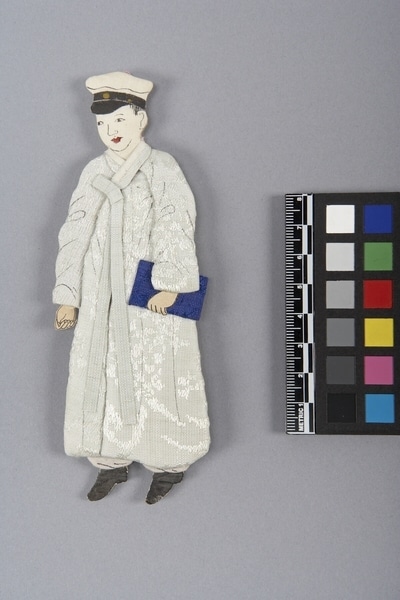Doll Item Number: Ed1.132 from the MOA: University of British Columbia

Description
Figure representing a person on a flat backing of white paper. Front view is depicted of the figure which is made of cloth lightly padded to give a three-dimensional effect having each portion made of a separate piece of cloth with painted details. Hands are made of paper. Face is made of white silk. Carrying a blue rectangular object under the figure's left arm. Wearing a white, and black naval officer's type hat, an ankle-length grey patterned silk gown fastened at the upper right with a ribbon of the same, loose darker grey trousers, and black paper boots. Two pieces of white flannel hemmed with light red-pink silk thread with a loop of the same at the top are sewn to the paper backing.
History Of Use
Figure represents a student of the period 1920-1935, when Korea was under Japanese rule, and Japanese and western influences were reflected in changes in dress, such as the student's hat. Such figures were made during the time when Korea was first open to the outside world (after the mid 1890s), probably as gifts to present to missionaries or other visitors from foreign countries. Flat dolls like these were very popular during the period 1910-20. Before that time, shamans made dolls that they sold to their clients, as images of those the clients wanted to exorcise. Simple dolls were made of straw for children to play with. After Korea opened, people began to see dolls as artistic objects. They were made in workshops by masters, using authentic fabrics whenever possible, as their purpose was to introduce foreigners to Korean society.
Such clothes were worn by modern male students in the period after 1910 who were attending secondary school or university. Their hair was cut in western style. They wore western military style school hats with school badges and western shoes, with long Korean coats, “Doo-ru-ma-gui”.
Narrative
Collected by J. H. Morris while he was chief engineer for Seoul Railway, Korea.
Specific Techniques
The clothing was stitched around the edge and then a layer was added inside the clothing. Each section was separately applied and pasted in place. The details were finely painted.
Item History
- Made in Korea during 1910
- Collected between 1910 and 1939
- Owned by Marion Stephan before August 1964
- Received from Marion Stephan (Donor) during August 1964
What
- Name
- Doll
- Identification Number
- Ed1.132
- Type of Item
- doll
- Material
- paper, silk fibre, cotton fibre, rayon fibre, paint and paste adhesive
- Manufacturing Technique
- spun, woven, cut, painted, sewn and pasted
- Overall
- height 14.9 cm, width 5.4 cm, depth 0.6 cm
Who
- Culture
- Korean
- Previous Owner
- Marion Stephan
- Received from
- Marion Stephan (Donor)
Where
- Holding Institution
- MOA: University of British Columbia
- Made in
- Korea
When
- Creation Date
- during 1910
- Collection Date
- between 1910 and 1939
- Ownership Date
- before August 1964
- Acquisition Date
- during August 1964
Other
- Condition
- good
- Current Location
- Case 77
- Accession Number
- 0113/0035